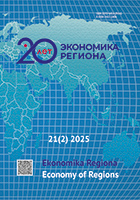Assessment of the Impact of the International North-South Transport Corridor on Transit Travel Time in Regional and Global Cargo Transportation
DOI:
https://doi.org/10.17059/ekon.reg.2025-2-6Keywords:
multimodal transportation, intermodal transportation, freight flow assignment, modelling, prediction, optimization of the transportation systemAbstract
Global and regional challenges are reshaping trade relations, supply chains, and cargo transportation routes. In this context, the International North-South Transport Corridor (INSTC) is gaining increased political and economic importance. This study evaluates congestion along sections of the corridor by analysing demand and infrastructure capacity in the regional transit logistics system. Using a game-theoretic model, the competitive behaviour of cargo flows under limited network capacity was simulated. Results indicate that with projected transportation demand between Saint Petersburg and Mumbai reaching 41 million tons per year by 2030, transit times between Europe and Asia via the INSTC could be reduced by 20–40 % compared to existing routes. The corridor remains attractive for transit volumes up to 80 million tons annually, and with targeted investments to expand capacity on 11 key network sections, it could handle up to 100 million tons per year. In the long term, the INSTC is expected to support 80 to 100 million tons annually, maintaining competitiveness in the global freight network and fostering regional economic development. Further investments in border crossings and transshipment hubs could expand capacity beyond 100 million tons, strengthening the corridor as a viable alternative for routes between Asia, Europe, India, and North America. These findings can inform development plans for the INSTC, transport policies of participating countries, and contribute to improving local living standards.
Downloads
Published
How to Cite
Issue
Section
License
Copyright (c) 2025 Alexander Krylatov, Марина Федорова, Анастасия Раевская

This work is licensed under a Creative Commons Attribution 4.0 International License.




